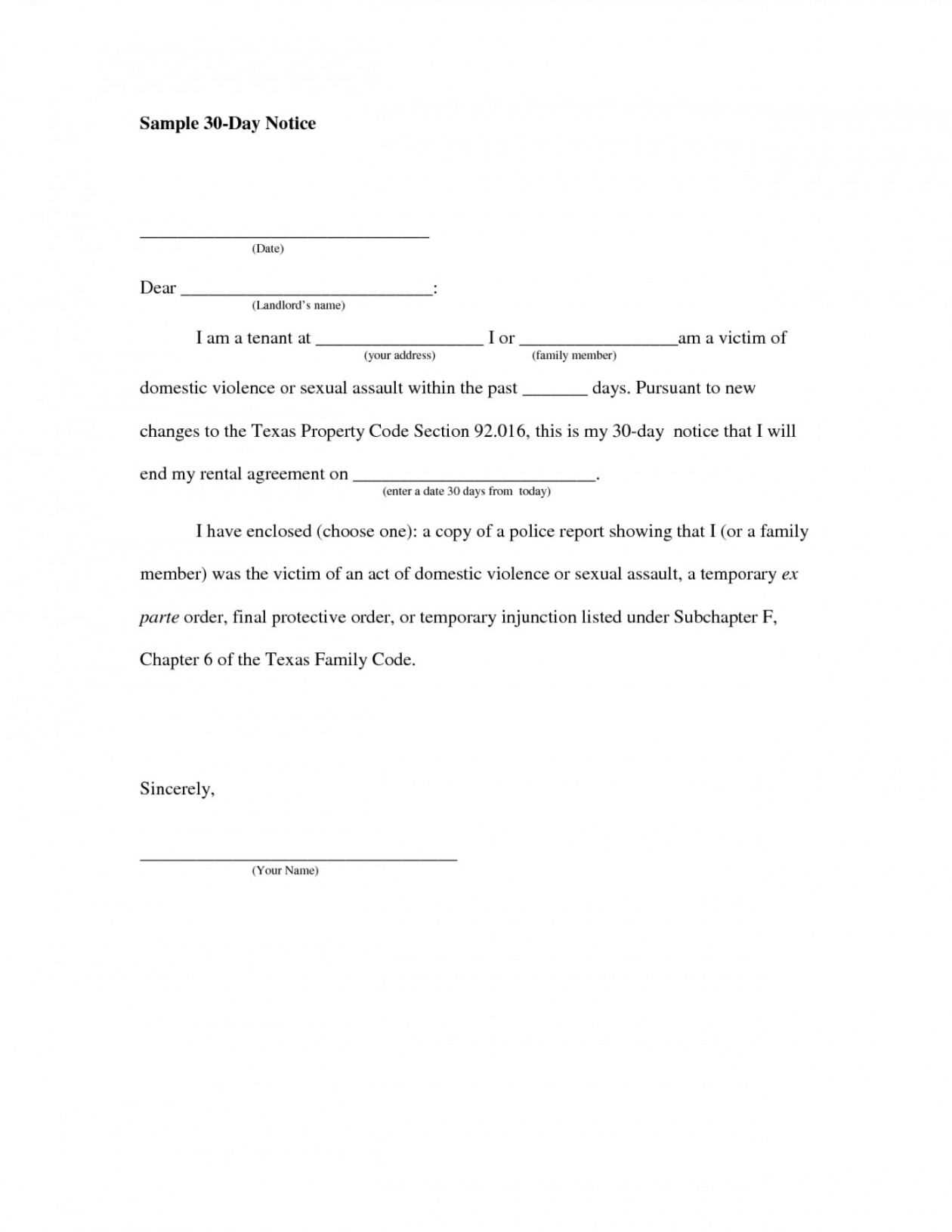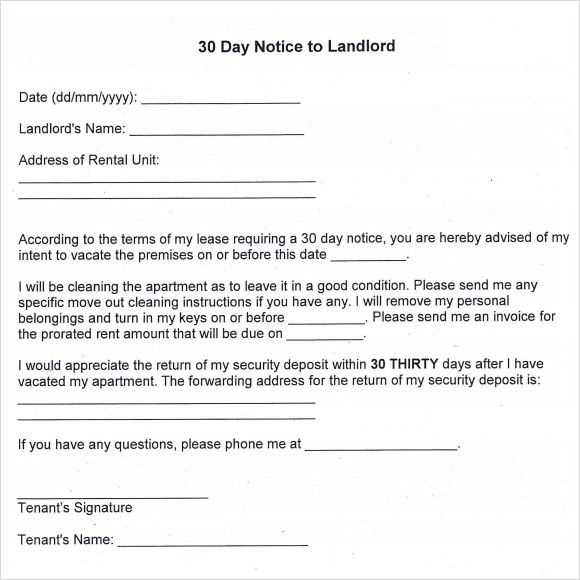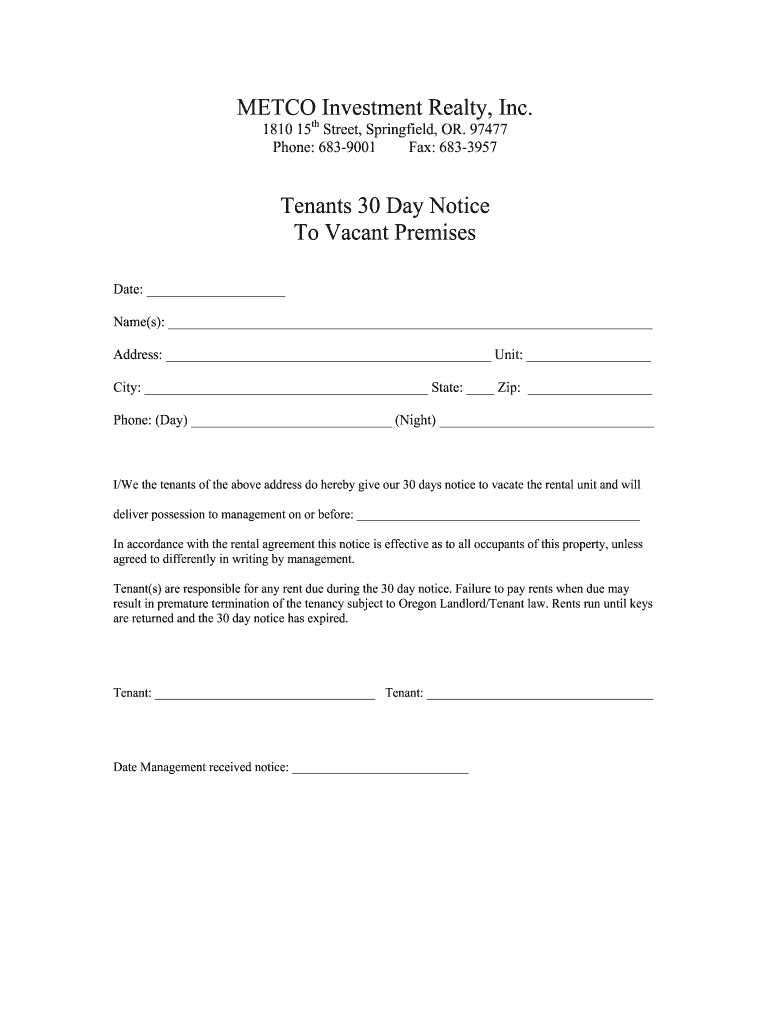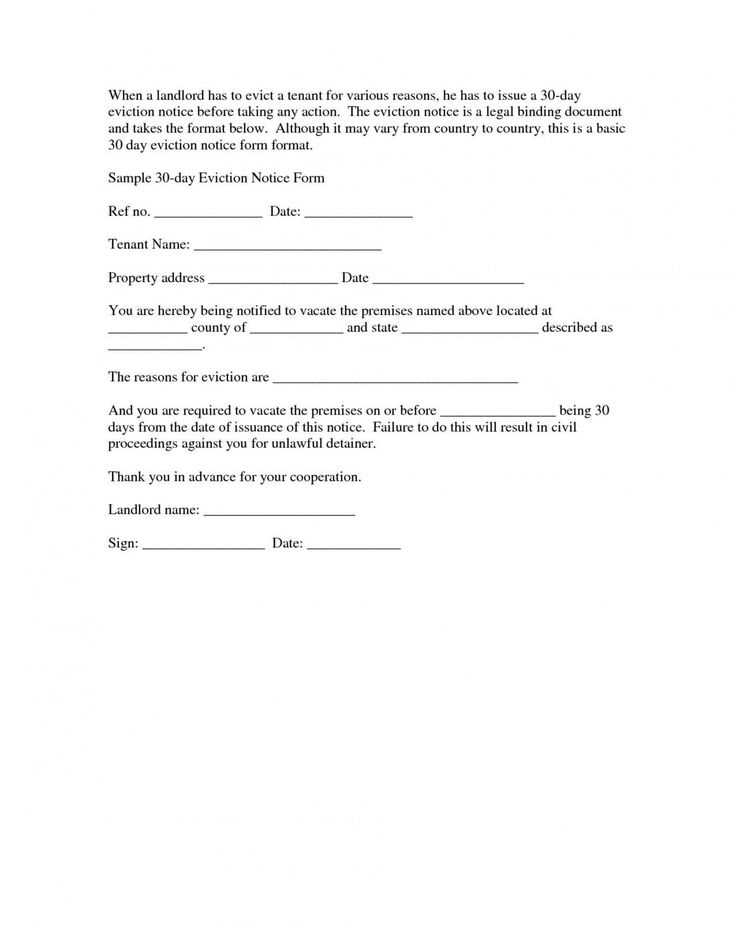30 Day Notice to Vacate Letter Template for Landlords

When you’re planning to move out of a rental, it’s essential to communicate your decision in advance. Properly informing the property owner ensures that both parties are aware of the upcoming change and can handle the transition smoothly. This proactive approach helps avoid potential misunderstandings and legal issues.
By following a clear and professional format, tenants can express their intent to leave while ensuring they meet all contractual obligations. A well-structured message not only fulfills legal requirements but also maintains a positive relationship between tenant and property owner, which can be beneficial for future references.
Understanding the proper format for such a communication can simplify the process. It involves providing specific details and adhering to the agreed-upon timeframe, which allows both sides to prepare for the move efficiently. This method also minimizes the chance of unnecessary delays or complications.
Understanding the 30 Day Notice Requirement
When you decide to leave a rental property, informing the property owner in advance is not only courteous but also a legal necessity. The timeframe for notifying the owner ensures there is enough time for both parties to prepare for the transition. Meeting this requirement is crucial to avoid any penalties or complications during the process.
The duration of the notice period is often specified in the rental agreement and allows both the tenant and the owner to make necessary arrangements. For tenants, it gives time to pack, find a new residence, and settle any outstanding issues, while owners can begin preparing for a new tenant. Ensuring you fulfill this obligation on time can help maintain a good relationship with the owner and protect your rights under the rental agreement.
Importance of Notifying Your Landlord Early
Giving advance notice when you plan to move out is an essential step in ensuring a smooth transition. Informing the property owner early allows both sides to prepare adequately for the change, reducing the risk of any misunderstandings or conflicts. A timely alert can make the process more organized and less stressful for everyone involved.
By notifying the owner well in advance, you demonstrate respect for the rental agreement and provide sufficient time for them to seek a replacement tenant. Additionally, it helps you avoid possible fees or penalties that may arise from failing to meet the agreed-upon terms. Early communication also leaves room for negotiating any final details, such as the return of your deposit or addressing repairs, helping maintain a positive relationship with the owner.
How to Write a Notice to Vacate

When preparing to inform your property owner about your move, it’s important to follow a clear and professional approach. The communication should be concise yet thorough, outlining your intentions while providing necessary details. A well-crafted message helps avoid confusion and ensures that both parties are aligned on expectations.
Key Information to Include
Begin by stating your intention to end the agreement, including the planned move-out date. Clearly mention any important details, such as the condition of the property and your availability for inspections. It’s also a good practice to acknowledge any outstanding responsibilities, such as paying the final month’s rent or returning keys.
Maintaining Professionalism
Keep the tone of your message polite and respectful. Even if you’re moving due to dissatisfaction with the property, maintaining professionalism ensures that the process remains smooth and that you leave on good terms. A positive communication style can also be beneficial in case you need a reference for future rentals.
Key Elements to Include in Your Letter
When preparing to inform your property owner of your decision to move out, it’s important to include certain essential details to ensure clarity and avoid any misunderstandings. A well-structured communication will cover all necessary information and demonstrate professionalism, helping both parties manage the transition smoothly.
Essential Information to Provide

- Move-out Date: Clearly state the date you intend to leave the property.
- Property Address: Include the address of the rental unit to avoid confusion.
- Reason for Moving: While not mandatory, you may choose to explain why you’re leaving.
- Contact Details: Provide your updated contact information in case follow-up is needed.
- Requests for Final Inspection: Mention your availability for a property inspection before departure.
Additional Considerations
- Security Deposit: Discuss the return of your deposit and any potential deductions.
- Final Rent Payment: Confirm the status of any outstanding payments or agreements.
- Key Return: Include information about the return of keys or access devices.
Legal Considerations When Moving Out
When you decide to leave a rental property, it’s essential to be aware of your legal rights and obligations. Failing to follow the required procedures or missing important details can lead to potential disputes or penalties. Understanding the legal aspects helps ensure that you fulfill your responsibilities while protecting your interests.
Lease Agreement: Review your rental contract to confirm the terms regarding termination. The agreement likely outlines the required notice period and other stipulations, such as penalties for early termination or specific conditions for ending the contract.
Security Deposit: Be sure to clarify the conditions under which your deposit will be returned. Property owners often have the right to deduct from the deposit for damages or unpaid rent, so ensure the property is in good condition before leaving to avoid unnecessary charges.
Final Rent Payment: Make sure you settle all financial obligations before moving out, including any last month’s rent or utility payments. Keeping receipts and documentation of payments can help resolve any issues that might arise later.
Understanding these legal factors is key to a smooth and problem-free transition out of the property. By fulfilling all contractual obligations, you maintain a professional relationship with the property owner and avoid future complications.
Tips for a Smooth Lease Termination

Ensuring a seamless transition when ending a rental agreement requires careful planning and attention to detail. By following the right steps, you can avoid any unnecessary complications and leave the property on good terms. Proper communication, preparation, and respect for the terms of the agreement are essential to making the process as smooth as possible.
Clear Communication with Your Property Owner
It’s crucial to communicate your intentions to the property owner well in advance. Be clear and concise about your plans, providing all necessary details, such as the date you intend to leave and any requests for inspections or final arrangements. This shows respect for the agreement and helps both parties prepare for the upcoming changes.
Prepare the Property and Settle Finances
Property Condition: Make sure the property is in good condition before your departure. Take the time to clean and repair any damage that may have occurred during your stay. This can help ensure that your security deposit is returned in full.
Financial Responsibilities: Double-check any outstanding payments, including rent and utilities, to avoid complications later. Keep a record of all payments and receipts to prevent disputes over charges after you’ve moved out.
By following these tips, you ensure a smooth and hassle-free end to your lease, protecting both your financial interests and your reputation with the property owner.